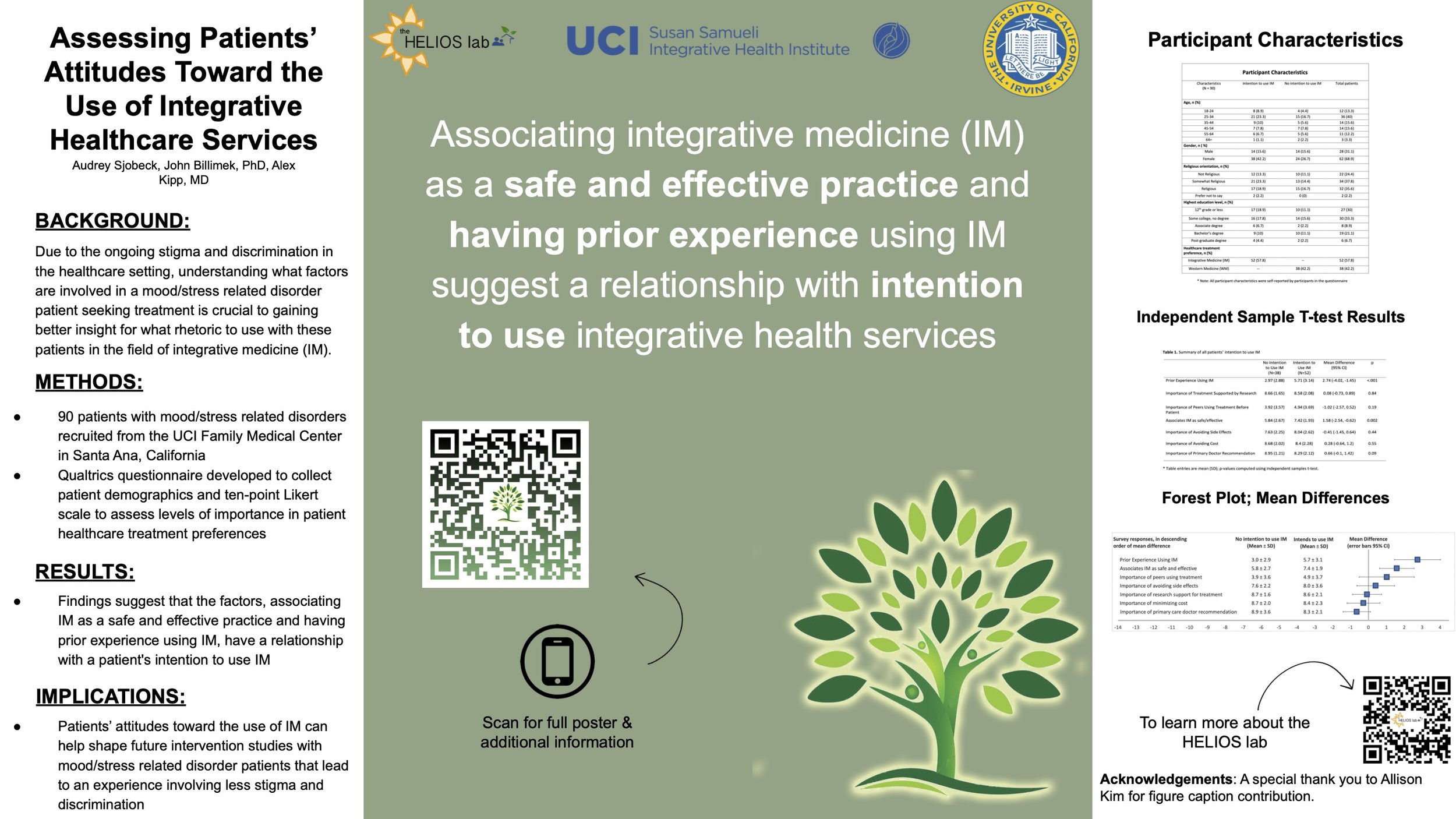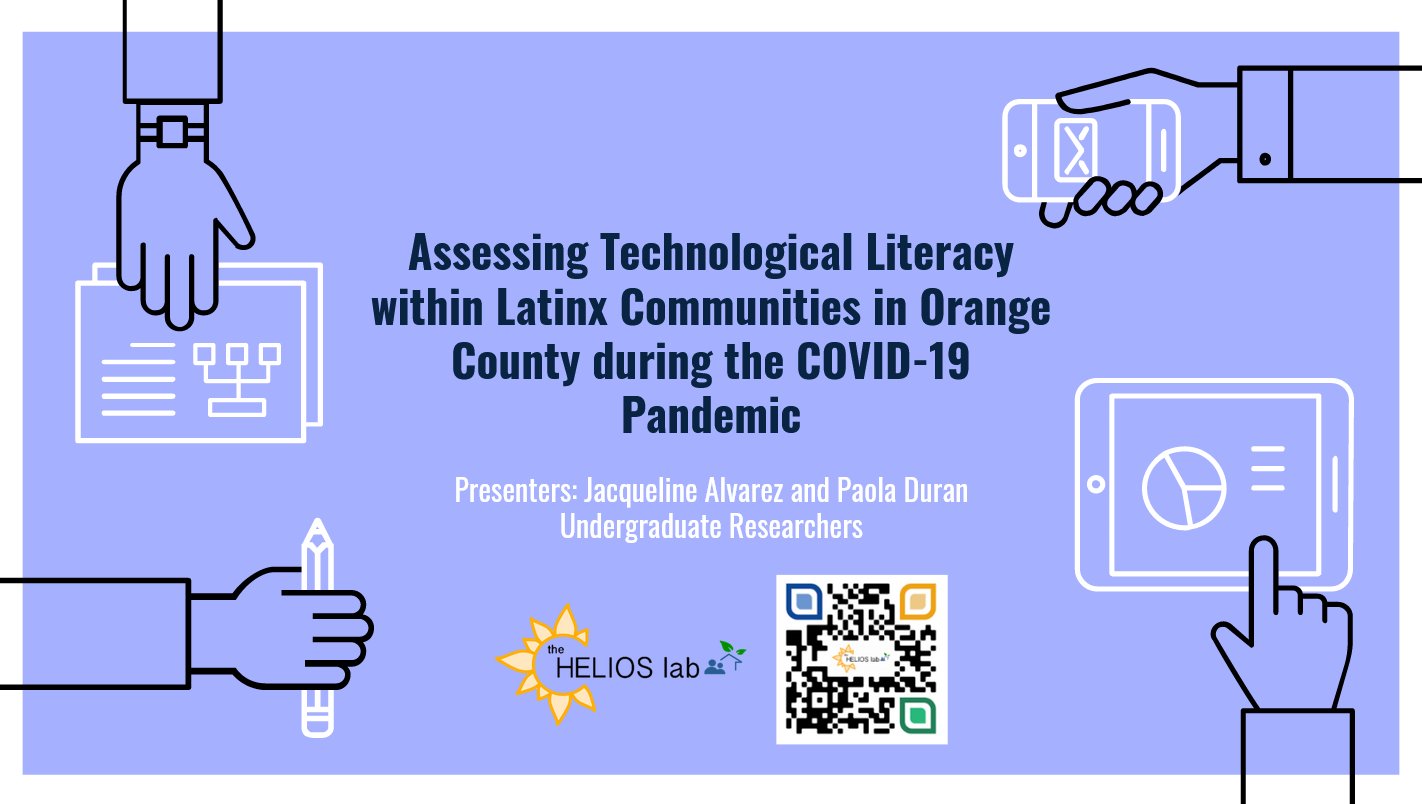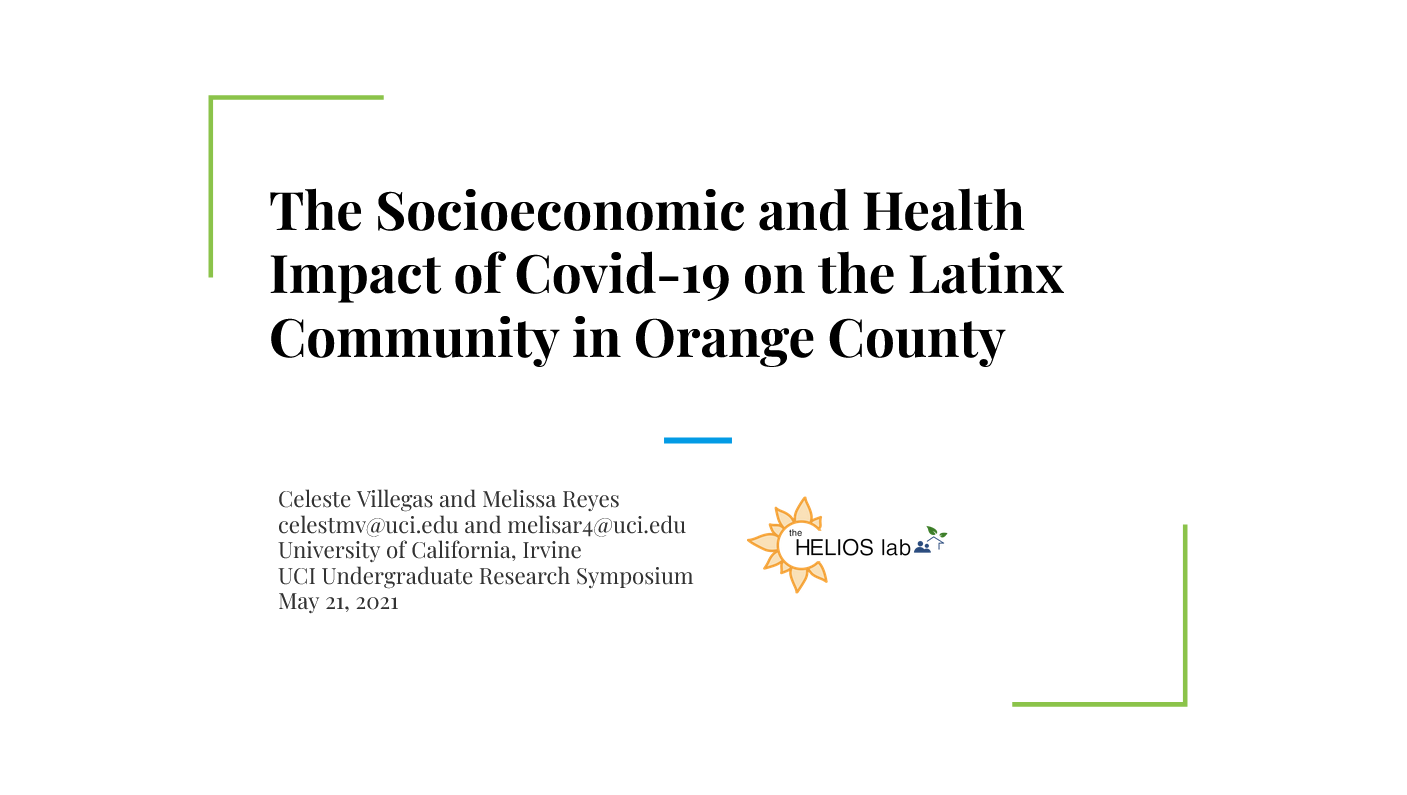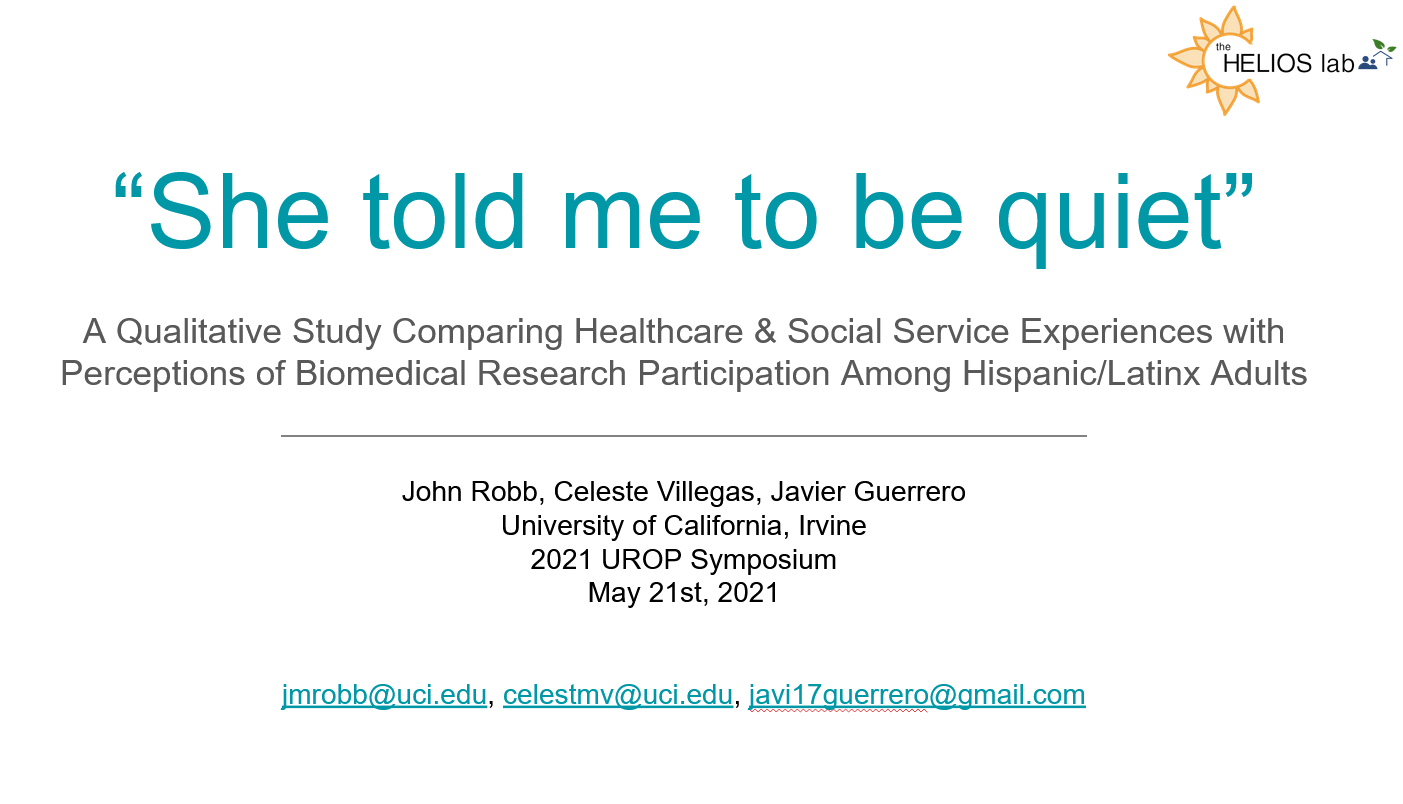2023 Posters & Presentations
Medication Hesitancy and Blood Pressure Medication Adherence Among Latinx Adults with Hypertension
Claire Ali-Khan
(she/her/hers)
Pharmaceutical Sciences
Class of 2024
Melanie Lopez
(she/her/hers)
Public Health Science & Public Health Policy
Class of 2022
Non-adherence to medication is very common among the Latinx population and often has detrimental impacts on patients’ lives, and may be related to the mistrust of medication and healthcare professionals. The purpose of this project is to examine the connection of patient-reported hesitancy to an objective measure of adherence to blood pressure medication among Latinx Adults with hypertension. Medication hesitancy was collected using the Beliefs About Medicines Questionnaire (BMQ), which was scored to categorize patients into high vs. low hesitancy groups. Patients were then asked to use a digital pill-bottle cap monitor (MEMS caps) to estimate adherence by recording time stamps for everytime the bottle is opened for a 30 day monitoring period. Nonadherence was defined as taking less than 80% of the prescribed doses over 30 days, and was compared between high hesitancy and low hesitancy groups of patients using Fisher’s exact test. In total, 44 patients (average ± SD age = 56 ± 9 years, 73% female, 98% born outside the US) completed the protocol, with 15 (34%) categorized as high hesitancy and 29 (66%) as low hesitancy. 67% of high hesitancy versus 45% low hesitancy patients exhibited nonadherence in their MEMS cap data (p=0.20). Although not statistically significant, the magnitude of the difference is large and warrants further investigation in a larger sample to determine the association of medication hesitancy with subsequent nonadherence in this population.
Assessing Patients’ Attitudes Toward the Use of Integrative Health Services
Audrey Sjobeck
(she/her/hers)
Psychology
Class of 2023
Relevant literature demonstrates that stigma and discrimination in the healthcare industry from language often leads to apprehensive attitudes toward receiving proper treatment for patients’ conditions, limiting the treatment options patients have. Understanding what factors are involved in a patient seeking treatment is crucial to gaining better insight for what rhetoric to use with these patients in the field of integrative medicine (IM). In a pilot study involving 90 patients with mood/stress related disorders from the UCI Family Medical Center in Santa Ana, California, patients’ attitudes toward IM services were assessed. Taking approximately five minutes per questionnaire, a background assessment was used to collect patient demographics such as age, gender, education level, religious orientation, and preference for integrative or western medicine. Immediately following was a ten-point Likert scale survey that prompted the patient to rank various levels of importance in healthcare treatment preferences such as cost of care, symptom management, friend/family experiences, and reputability of the care itself. The pilot study was interpreted through an analysis of variance using an independent sample t-test. Findings suggest that factors such as associating IM as a safe and effective practice and having prior experience using IM, have a relationship with a patient's intention to use IM. The factors associated with patients’ attitudes toward the use of IM can help shape future intervention studies of interpreting which types of language used with mood/stress related disorder patients lead to an experience that involves less stigma and discrimination.
A Pilot Study of Diabetes Education Videos to Reduce Knowledge Gaps in Patients from an FQHC
The UCI Family Health Center in Santa Ana serves predominantly low-income Latinx Spanish-speaking patients, many of whom have type 2 diabetes mellitus. Physicians have limited time to assess the patient’s diabetes, their overall level of knowledge of the disease and important gaps in that knowledge. To help establish a baseline of basic diabetes knowledge, we worked with a family medicine physician to develop a two-minute educational video about diabetes–how it affects the body and how to treat it–available in English and Spanish. Two versions were created in each language—one with visuals (graphics that complement the video content) and one without visuals (only the physician talking). In this pilot study, 38 patients were randomized to view one of the two versions in their preferred language. Patients then filled out a survey where they rated their understanding of the video content and to assess their diabetes knowledge. Although this study’s small sample size did not have statistical power to detect significant differences, descriptive analysis comparing understanding and knowledge between the patients in the two video versions showed the overall level of understanding was high and knowledge was moderate. Knowledge scores were higher in participants with visuals (79.2% [SD]) versus those without visuals (72.2% [SD]), suggesting a hypothesis that visuals increase knowledge gain is worth exploring further. The main finding is that health education videos can be well-received and understandable to patients, with or without visuals. Research in this domain is important for proper patient education and improved health outcomes.
Naomi Ferrer
(she/her/hers)
Biological Sciences
Class of 2025
William Hernandez
(he/him/his)
Psychological Science, Social Ecology
Class of 2024
Jeffrey Garcia
(he/him/his)
Biological Sciences
Class of 2023
Gabriela Lopez Ruano
(she/her/hers)
UCI SOM Postbacc
Class of 2023
Angyelisa Hernandez
(she/her/hers)
Chemistry
Class of 2026
Effects of Health-Related Social Control on Medication Adherence in Latinx Patients with Hypertension
Sidra Ali
(she/her/hers)
Public Health Sciences
Class of 2023
Latinx adults are more likely to have untreated hypertension (HTN) than any other race-ethnic group nationally. Medication adherence proves to be a key variable for HTN management and research is examining influences from one’s social network. An understudied social influence is health-related social control (HRSC), which focuses on interpersonal interactions that specifically entail influence and regulation. HRSC control has two main subtypes: pressure or persuasion. As such, this study aims to investigate the effects of HRSC on medication adherence in Latinx adults diagnosed with hypertension. Data was collected through a baseline questionnaire from the Mi Propio Camino study. Medication adherence was measured using Morisky Medication Adherence Scale and HRSC was assessed with ten questions regarding behaviors expressed by loved ones on a 6 point Likert scale. We ran a binary logistic regression between medication adherence and HRSC components and used participant ratings at 25th and 75th quartile to see how changes in the level of pressure and persuasion may impact medication non-adherence. We found that participants with higher levels of persuasion were more likely to be non-adherent than those reporting lower levels (p= 0.04), while pressure did not have a statistically significant relationship (p= 0.96). Additionally, 75% of participants with both low and high levels of pressure were non-adherent. Comparatively, 83% of individuals with reports of high persuasion were non-adherent, while 67% of those with reports of low persuasion were non-adherent. To better understand this relationship, we will conduct focus groups with participants to hear their direct experience.
Sleep Quality as a Protective Factor for Latinx Hypertensive Patients Facing Financial Stress
Latinos are the largest minority group in the U.S. with the leading cause of death being cardiovascular disease (CVD). Previous research has shown that stress and sleep contribute to hypertension, a risk factor for CVD. However, the interplay between sleep quality and stress has not been investigated extensively as a risk factor for hypertension among Latinos. Financial stress has been associated with a higher risk for myocardial infarction and worse self-rated health. Within the study, we see if sleep quality is a protective factor against exposure to financial stress. Latino adults (n=208) were recruited from a federally qualified health center. Self-reported sleep quality in the past 7 days and current financial stress were assessed. Systolic (SBP) and diastolic (DBP) blood pressure were measured. We hypothesized that there would be a relation between financial stress and blood pressure, which would be moderated by sleep quality. We found a significant difference in sleep quality (t = 6.3, p <.001) between those with high versus low financial stress but not a difference in SBP or DBP (p > 05). We found a significant interaction between financial stress and sleep quality on DBP (F = 4.54, p = .03), wherein patients with high financial stress and low sleep quality had worse DBP (M = 86.59, SD = 13.34) than those with high financial stress and high sleep quality (M = 79.31, SD = 8.56). Our results reveal that among Latino patients, sleep quality may be protective for Latinx hypertensive patients facing financial stress.
William Hernandez
(he/him/his)
Psychological Science, Social Ecology
Class of 2024
Claire Ali-Khan
(she/her/hers)
Biological Sciences
Class of 2024
Andrea Serrano
(she/her/hers)
Psychological Sciences, Chicano Latino Studies
Class of 2024
Aracely Blanco
(she/her/hers)
Public Health Sciences
Class of 2024
Communication narratives on cervical cancer prevention among Latina mothers of daughters
Latinas are 40% more likely to be diagnosed with, and 30% more likely to die from cervical cancer compared to non-Latina whites. Previous research has found family support informs whether young adult Latina women obtain HPV vaccination, an effective form of cervical cancer prevention. We examined the perspective of Spanish-speaking Latina mothers about their communication on cervical cancer prevention with their daughters. A total of 12 semi-structured interviews were conducted with Latina mothers who were mostly recruited from a larger NIH-funded project, Mi Propio Camino. Questions included topics on health knowledge, their relationships with their daughters, and mothers’ level of involvement in their daughter’s health decisions. Data were analyzed with the qualitative software program Dedoose, using both deductive and inductive coding. Participants were between 45-64 years old, and 75% of them had health insurance. We found that most participants have had Pap smears in the past, did not know about the HPV test, and only a few were aware of the HPV vaccine. Themes included: limited knowledge of cervical cancer, mothers believing it's their responsibility to inform daughters about cervical cancer prevention, feelings of shame from their Pap smear experiences, lack of access to care due to limited resources and lack of insurance, and positive mother-daughter relationships. A unique finding included some mothers' interest in daughters spreading health information to their peers. It is suggested to explore the communication among Latina siblings or peers, as an effective avenue to spread information on cervical cancer and its prevention.
Esmeralda Garcia-Castellanos
(she/her/hers)
Biological Sciences
Class of 2023
Michelle Beltran Najera
(she/her/hers)
Public Health Sciences
Class of 2023
Brianna Flores
(she/they)
Biological Sciences
Class of 2023
Changing Minds or Following Interests? Predictors of behavior change in Latinx hypertension patients in the Mi Propio Camino study.
Managing a chronic health condition like hypertension requires adopting self management behaviors like taking medications and following a healthy lifestyle. Health education interventions focus on encouraging participants to adopt these behaviors with mixed success. The present study examines the degree to which the adoption of new self management behaviors observed in a health education intervention can be attributed to the interests that participants already held prior to the start of the intervention versus developing new interests during the intervention. We are analyzing data from the Mi Propio Camino hypertension education study, in which 205 Spanish-speaking Latinx patients have completed a 4-session series of weekly group education classes. Prior to the classes, participants completed validated questionnaires assessing level of interest in and prior adoption of six different hypertension self management behaviors (medication taking, healthy eating, physical activity, nutritional supplements, stress management and sleep hygiene). Then in the classes, strategies to increase all of these behaviors were presented, and participants were invited to choose which behaviors they wished to adopt. Adoption of each behavior was assessed again throughout the four week course using a daily diary, and after the final session using the same questionnaire from baseline. Our team is currently analyzing (1) the percentage of patients that adopted each behavior, and (2) the correlation between baseline interest in a specific behavior and the likelihood of adopting that behavior. These findings will add to the evidence on the merits of following participants’ prior interests versus introducing new strategies when designing health education interventions for Latinx hypertension patients.
Daniela Garcia
(she/her/hers)
Biological Sciences
Class of 2023
Nydia Gomez
(she/her/hers)
Public Health Sciences
Class of 2023
Allison Kim
(she/her/hers)
Biological Sciences
Class of 2024
Angelique Nguyen
(she/her/hers)
Biological Sciences
Class of 2023
2022 Posters & Presentations
Food Insecurity and Time to COVID-19 Vaccination
Kayla Miles
(she/her/hers)
Public Health Science
Class of 2022
Sorina Long
(she/they)
Public Health Science
Class of 2022
COVID-19 has disproportionately impacted vulnerable populations. It is crucial to understand vaccination barriers to guide policies that address socioeconomic factors that impede vaccination uptake. Food insecurity, or the inability to meet nutritional needs, has been shown to affect access to some preventive services. Therefore, we examined the correlation between food insecurity and COVID-19 vaccination uptake. We retrospectively studied Spanish-speaking hypertensive adult patients (n = 285) in a federally qualified health center in Orange County, comparing the vaccination times of both food insecure and non-food insecure groups.We collected data from electronic health records and used survival analysis (Kaplan-Meier test) to analyze the correlation between food insecurity and time to COVID-19 vaccination. Participants mean (SD) age was 58 ± 10 and 67.6% were women. Median time for vaccination with the first dose was 106 days for both food insecure and non-food insecure participants. For the second dose median time was 28 days for the non-food insecure group while the food insecure group was 29 days. For the booster, median time for food insecure participants was 270 days and 282 days for non-food insecure participants. Time to first dose, second dose, and booster shot were similar between food insecure and food insecure patients (all p’s>0.05), indicating no significant difference between groups. The lack of influence food insecurity has on vaccination timing is a significant finding, indicating the need to allocate resources to other socioeconomic factors that have a greater impact on vaccination uptake and by extension implementing more effective policies.
Examining the Correlation of A1C Levels with Knowledge in Diabetes in Spanish Speaking FQHC Patients
Esmeralda Garcia-Castellanos
(she/her/ella)
Biological Science
Class of 2023
Latines in the U.S. have a greater risk of developing type 2 diabetes, and once diagnosed, have worse outcomes compared to other groups, often attributed to limited health literacy. To determine if diabetes health literacy is related to diabetes self-management, primarily Spanish-speaking patients (N=52) averaging 55-64 years of age were assessed through the Spoken Knowledge in Low Literacy in diabetes scale (SKILLD), a 10-item scale evaluating diabetes knowledge in patients at the UCI FQHC. SKILLD Scores were compared between patients with blood sugar (measured as hemoglobin A1c) “above target” vs. “at target” of 8.0% using an independent samples t-test. Above target patients had a mean SKILLD score of 6.2, compared to at target patients with a mean score of 5.2 (p= 0.212). Knowledge on most of the 10 items was similar between the two groups, with the exception of knowledge about symptoms of high blood sugar (answered correctly by 77 % of above target vs. 40% of at target patients; p= 0.009). This outcome might be due to increased intervention of patients with more severe diabetes. Although the sample size was limited, there is no evidence for an association between lower knowledge and poorer diabetes control. In fact, patients with higher A1cs may have as much or more knowledge as patients with lower A1c. Future studies should consider the benefits of addressing knowledge gaps alongside other factors to drive successful diabetes management, and should include larger samples with more comprehensive assessment of potential confounding variables.
Validating the Safran Reasons for Adherence Scale Among Latinx Adults with Hypertension
Melissa Reyes
(she/her/hers)
Biological Science
Class of 2022
Shary Castro Alvarez
(she/her/hers)
Psychological Science
Class of 2023
Mirleth de los Santos
(she/her/hers)
Biological Science
Class of 2022
Medication nonadherence contributes to disparities in chronic disease outcomes among Latinx communities. Prior research shows that the Safran Reasons for Nonadherence Scale (SRNS) is a valid predictor of health outcomes for Latinx adults with diabetes. We examined the validity of expanding the use of the SRNS to predict successful hypertension management. Spanish-speaking adult hypertension patients were invited to monitor their medication adherence using a pill bottle cap monitor (MEMS cap) that recorded every time the bottle was opened for a 30 day period. After 30 days, MEMS caps were collected, blood pressure (BP) was measured and the SRNS was collected for each patient. Participants were categorized as “Self-reported adherent” or “Self-reported nonadherent” based on SRNS responses. Objective nonadherence was defined from MEMS data as <80% of prescribed doses taken, and was compared between the self-reported adherent versus nonadherent groups using Fisher’s exact test. BP was compared between adherent versus nonadherent patients for both measures with independent samples t-tests. Of the 44 participants completing the study, self-reported adherent (N=15) versus nonadherent (N=29) patients did not differ in objective nonadherence rates (53% vs. 52%, respectively; p=0.99). BP did not differ between self-reported adherence groups, but systolic BP was significantly higher among objective nonadherent vs. adherent patients (150±19mmHg vs. 128±12mmHg; p<0.001). Although the sample size is limited, there is no strong evidence that the SRNS is a valid predictor of objective nonadherence or BP, but objective nonadherence measured by MEMS caps is highly predictive of BP.
Assessing Pre-Post Changes to Intervention Session in Knowledge, Attitudes, Behaviors, and Blood Pressure Within Hypertensive Latinx Patients from the UCI Family Health Center in Santa Ana
Paola Duran
(she/her/hers)
Biological Science
Class of 2022
Spanish-speaking, Latinx adults with hypertension are disproportionately affected by poor blood pressure control linked to lower uptake of recommended management strategies and less access to culturally and linguistically appropriate services. Group health education classes offered in Spanish and focused on peer support and individualized goal setting may help improve management behaviors and outcomes. In a longitudinal, observational study, we examined changes in knowledge, attitudes, behaviors, and blood pressure among Spanish-speaking Latinx hypertensive patients from the UCI Family Health Center in Santa Ana participating in four weekly classes. A total of 44 females and 16 males averaging 56 years of age participated. Surveys and blood pressure measurements were collected pre and post-intervention, with pre to post changes examined with paired t-tests for continuous variables and McNemar’s test for categorical variables. Knowledge scores did not change significantly, but attitudes towards blood pressure management improved, with the proportion of patients reporting negative beliefs about medications dropping from 71.1% to 40.0% (p=0.003). There were modest increases in health behaviors, including an increase in patients engaging in breathing exercises to reduce stress from 50% to 82% (p=0.022). Marginal blood pressure changes were observed for average (±SD) systolic (pre: 142 ± 17mmHg vs. post: 138 ± 14mmHg; p=0.065) and diastolic (pre: 85 ± 10mmHg, post: 83± 9mmHg; p=0.103) readings. These findings suggest that group health education classes offered in Spanish can promote positive attitudes about behavior change even if knowledge ratings do not change significantly.
¿Cómo Voy a Llegar a la Clínica?: Hypertensive Latinx Patients’ Journey to a Federally Qualified Health Center in Santa Ana, CA
Liliana Chau
(she/her/hers)
Chemistry (Chemical Biology)
Class of 2022
Danielle Zaragoza
(she/her/hers)
Biological Science
Class of 2022
Brianna Flores
(she/they)
Biological Science
Class of 2023
Patients' ability to attend appointments is vital for managing their chronic illness and overall preventing more serious health outcomes. Transportation may act as a barrier to healthcare access within the Latinx community, especially patients who lack control over their transportation. Latinx patients with hypertension who see healthcare providers at an FQHC in Santa Ana completed a questionnaire as a part of an NIH-funded study. A multivariable adjusted model indicated that distance was not statistically significant (p-value = 0.61) in not attending hypertension health classes. However, this study highlights and validates a patient’s journey to receiving care, as transportation is oftentimes overlooked when a patient attends their visit. Of the patients that completed the questionnaire (n=284), there were 90 males and 192 females, with a mean age of 58.2 (± 9.98). For patients that relied on another person to drop them off (n=25), 12% were male and 88% were female. For patients that rely on transportation (n=17), 11.8% had an income above $20,000 and 70.5% had an income below $20,000. This suggests that gender and income influence how much autonomy patients have with their transportation, which may act as a barrier for healthcare access within the Latinx community. However, this data is limited to Orange County and is not representative of the whole Latinx community. Therefore, data should be collected beyond Santa Ana to better understand how transportation could act as a barrier for the Latinx community in managing chronic illness(es).
Medication Hesitancy and Blood Pressure Medication Adherence Among Latinx Adults with Hypertension
Claire Ali-Khan
(she/her/hers)
Pharmaceutical Science
Class of 2024
Melanie Lopez
(she/her/hers)
Public Health Science & Public Health Policy
Class of 2022
Non-adherence to medication is very common among the Latinx population and often has detrimental impacts on patients’ lives, and may be related to the mistrust of medication and healthcare professionals. The purpose of this project is to examine the connection of patient-reported hesitancy to an objective measure of adherence to blood pressure medication among Latinx Adults with hypertension. Medication hesitancy was collected using the Beliefs About Medicines Questionnaire (BMQ), which was scored to categorize patients into high vs. low hesitancy groups. Patients were then asked to use a digital pill-bottle cap monitor (MEMS caps) to estimate adherence by recording time stamps for everytime the bottle is opened for a 30 day monitoring period. Nonadherence was defined as taking less than 80% of the prescribed doses over 30 days, and was compared between high hesitancy and low hesitancy groups of patients using Fisher’s exact test. In total, 44 patients (average ± SD age = 56 ± 9 years, 73% female, 98% born outside the US) completed the protocol, with 15 (34%) categorized as high hesitancy and 29 (66%) as low hesitancy. 67% of high hesitancy versus 45% low hesitancy patients exhibited nonadherence in their MEMS cap data (p=0.20). Although not statistically significant, the magnitude of the difference is large and warrants further investigation in a larger sample to determine the association of medication hesitancy with subsequent nonadherence in this population.
Examining Attendance Predictors for Hypertensive Intervention Sessions
Jacqueline Del Carmen Alvarez
(she/her/hers)
Public Health Science
Class of 2022
Joseline Magana
(she/her/hers)
Public Health Science
Class of 2023
Marginalized groups in the United States encounter barriers that prevent their access to healthcare. The aim of this study is to better understand what influences patients’ motives to attend in-person health education classes. Participants were recruited for the Mi Propio Camino (MPC) study and completed a baseline questionnaire that collects data on their demographics, beliefs about medications, food insecurity, readiness to change, and attitudes between patient and provider interactions. Data on patient attendance for at least one MPC class was collected using RedCap. Upon bivariate analyses, there were a total of 284 participants with an average age of 58.24 (± 9.98) and composed of 60% of female participants. The only significant variable associated with class attendance was patients’ readiness to change (RTC). The RTC data collected considered changes in multiple healthy lifestyle strategies, and for every 1 point increase in RTC score, participants were twice as likely to attend an MPC class. Notably, age (p-value= 0.013), distance (p-value=0.61) to the intervention site, and food insecurity (p-value=0.14) were not significant predictors of class attendance. These findings suggest that readiness to change plays a significant role when participants are deciding whether to attend educational classes. Research can be done to further understand ways to increase patient attendance, for instance, participants' perception of RTC values.
Assessment of the Correlation of Medication Beliefs with Time to COVID-19 Vaccination
Shifa Haquani
(she/her/hers)
Biological Science
Class of 2022
Nancy Dang
(she/her/hers)
Human Biology & Anthropology
Class of 2022
Tatum Cravens
(she/her/hers)
Public Health Science
Class of 2022
Since the COVID-19 vaccine’s public release, there has been a drop in cases, signifying its importance in protecting our communities. Prior research indicates correlation between medication avoidance and influenza vaccine hesitancy. Therefore, we aim to explore disparities in vaccination by investigating the relationship between medication beliefs and the time to receiving COVID-19 vaccinations, to evaluate for a similar trend. In this study, responses from the Beliefs about Medication Questionnaire (BMQ) and medical records of 283 Spanish-speaking hypertensive adult patients (mean (SD) age = 58 (10)) at UCI FQHC in Santa Ana, CA were collected prior to 06/01/2021, when COVID-19 vaccines became widely available. Unadjusted survival analysis via the Kaplan-Meier test evaluated patient beliefs of the necessity and potential harms of medication to determine any differences in vaccination status between those with positive (necessity>concerns), neutral (concerns=necessity) or negative (concerns>necessity) medication beliefs. Median time to first dose, full vaccination and booster from administration of previous dose were 106, 28 and 243 days, respectively. In comparing time to event with medication beliefs, there was a marginal association between the three groups of medication beliefs and their time to the first dose (median time = 98, 106, and 115 for positive, neutral and negative groups, respectively; p=0.073), second dose (p=0.92), and booster dose (p=0.65). These findings show that medication beliefs alone may not differentiate time to COVID vaccination. Further research can analyze different measures of medication beliefs and co-variables in order to address health disparities.
2021 Posters & Presentations
2019 Posters & Presentations
Examining the Impact of Medication Beliefs on Medication Adherence Among Uncontrolled Hypertensive Patients
Justin Cha, Jacqueline Macias-Sandoval, Elizabeth Ordoñez, Michael Xu, Alexis Pellecer, Alejandra Villagomez, Helena Stevenson, Erick Deloera, Mimi Lam, Cristabel Nunez, Alexandra Garcia, Abhiruchi Chaulagain
Investigating the Lack of Minority Representation from the Latino/Hispanic Community in Biomedical Research through the Analysis of Community Seminars to Encourage Involvement
Melissa Ramirez, Jennifer Bui, John Robb, Raquel Hidalgo, Jessica Arizmendi De La Torre, Aeryus Holloway




















































